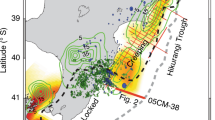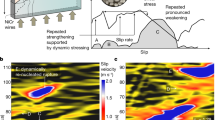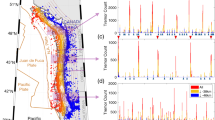Abstract
During the 2011 Tohoku-oki earthquake, extremely extensive coseismic slip ruptured shallow parts of the Japan Trench subduction zone and breached the sea floor1,2. This part of the subduction zone also hosts slow slip events (SSE)3,4. The fault thus seems to have a propensity for slip instability or quasi-instability that is unexpected on the shallow portions of important fault zones. Here we use laboratory experiments to slowly shear samples of rock recovered from the Tohoku-oki earthquake fault zone as part of the Japan Trench Fast Drilling Project. We find that infrequent perturbations in rock strength appear spontaneously as long-term SSE when the samples are sheared at a constant rate of about 8.5 cm yr−1, equivalent to the plate-convergence rate. The shear strength of the rock drops by 3 to 6%, or 50 kPa to 120 kPa, over about 2 to 4 h. Slip during these events reaches peak velocities of up to 25 cm yr−1, similar to SSE observed in several circum-Pacific subduction zones. Furthermore, the sheared samples exhibit the full spectrum of fault-slip behaviours, from fast unstable slip to slow steady creep, which can explain the wide range of slip styles observed in the Japan Trench. We suggest that the occurrence of SSE at shallow depths may help identify fault segments that are frictionally unstable and susceptible to large coseismic slip propagation.
This is a preview of subscription content, access via your institution
Access options
Subscribe to this journal
Receive 12 print issues and online access
$259.00 per year
only $21.58 per issue
Buy this article
- Purchase on Springer Link
- Instant access to full article PDF
Prices may be subject to local taxes which are calculated during checkout



Similar content being viewed by others
References
Fujiwara, T. et al. The 2011 Tohoku-Oki earthquake: Displacement reaching the trench axis. Science 334, 1240 (2011).
Ito, Y. et al. Frontal wedge deformation near the source region of the 2011 Tohoku-Oki earthquake. Geophys. Res. Lett. 38, L00G05 (2011).
Fukao, Y. & Kanjo, K. A zone of low-frequency earthquakes beneath the inner wall of the Japan Trench. Tectonophysics 67, 153–162 (1980).
Ito, Y. et al. Episodic slow slip events in the Japan subduction zone before the 2011 Tohoku-Oki earthquake. Tectonophysics 600, 14–26 (2013).
Nishizawa, A., Kanazawa, T., Iwasaki, T. & Shimamura, H. Spatial distribution of earthquakes associated with the Pacific plate subduction off northeastern Japan revealed by ocean bottom and land observation. Phys. Earth Planet. Inter. 75, 168–175 (1992).
Hino, R. et al. Aftershock distribution of the 1994 Sanriku-oki earthquake (Mw 7.7) revealed by ocean bottom seismographic observation. J. Geophys. Res. 105, 21697–21710 (2000).
Obana, K. et al. Aftershocks near the updip end of the 2011 Tohoku-Oki earthquake. Earth Planet. Sci. Lett. 382, 111–116 (2013).
Hashimoto, C., Noda, A., Sagiya, T. & Matsu’ura, M. Interplate seismogenic zones along the Kuril-Japan trench inferred from GPS data inversion. Nature Geosci. 2, 141–144 (2009).
Scholz, C. H. Earthquakes and friction laws. Nature 391, 37–42 (1998).
Ikari, M. J., Saffer, D. M. & Marone, C. Frictional and hydrologic properties of clay-rich fault gouge. J. Geophys. Res. 114, B05409 (2009).
Underwood, M. B. in The Seismogenic Zone of Subduction Thrust Faults (eds Dixon, T. H. & Moore, J. C.) 42–84 (Columbia Univ. Press, 2007).
Saffer, D. M. & Marone, C. Comparison of smectite- and illite-rich gouge frictional properties: Application to the updip limit of the seismogenic zone along subduction megathrusts. Earth Planet. Sci. Lett. 215, 219–235 (2003).
Chester, F. M., Mori, J. J., Eguchi, N., Toczko, S. & Expedition 343/343T Scientists. Integrated Ocean Drilling Program Vol. 343/343T (Integrated Ocean Drilling Program Management International, Inc., 2013).
Kameda, J. et al. Pelagic smectite as an important factor in tsunamigenic slip along the Japan Trench. Geology 43, 155–158 (2015).
Ikari, M. J., Kameda, J., Saffer, D. M. & Kopf, A. J. Strength characteristics of Japan Trench borehole samples in the high-slip region of the 2011 Tohoku-Oki earthquake. Earth Planet. Sci. Lett. 412, 35–41 (2015).
Ujiie, K. et al. Low coseismic shear stress on the Tohoku-Oki megathrust determined from laboratory experiments. Science 342, 1211–1214 (2013).
DeMets, C., Gordon, R. G., Argus, D. F. & Stein, S. Effect of recent revisions to the geomagnetic reversal time scale on estimates of current plate motions. Geophys. Res. Lett. 21, 2191–2194 (1994).
Baumberger, T., Berthoud, P. & Caroli, C. Physical analysis of state- and rate-dependent friction law II: Dynamic friction. Phys. Rev. B 60, 3928–3939 (1999).
Liu, Y. & Rice, J. R. Spontaneous and triggered aseismic deformation transients in a subduction fault model. J. Geophys. Res. 112, B09404 (2007).
Ide, S., Beroza, G. C., Shelly, D. R. & Uchide, T. A scaling law for slow earthquakes. Nature 447, 76–79 (2007).
Hirose, H., Hirahara, K., Kimata, F., Fujii, N. & Miyazaki, S. A slow thrust slip event following the two 1996 Hyuganada earthquakes beneath the Bungo Channel, southwest Japan. Geophys. Res. Lett. 21, 3237–3240 (1999).
Hirose, H. & Obara, K. Repeating short- and long-term slow slip events with deep tremor activity around the Bungo channel region, southwest Japan. Earth Planet. Space 57, 961–972 (2005).
Miyazaki, S., Segall, P., McGuire, J. J., Kato, T. & Hatanaka, Y. Spatial and temporal evolution of stress and slip rate during the 2000 Tokai slow earthquake. J. Geophys. Res. 111, B03409 (2006).
Wallace, L. M. & Beavan, J. A large slow slip event on the central Hikurangi subduction interface beneath the Manawatu region, North Island, New Zealand. Geophys. Res. Lett. 33, L11301 (2006).
Douglas, A., Beavan, J., Wallace, L. & Townend, J. Slow slip on the northern Hikurangi subduction interface, New Zealand. Geophys. Res. Lett. 32, L16305 (2005).
Ohta, Y., Freymuller, J. T., Hreinsdóttir, S. & Suito, H. A large slow slip event and the depth of the seismogenic zone in the south central Alaska subduction zone. Earth Planet. Sci. Lett. 247, 108–116 (2006).
Rogers, G. & Dragert, H. Episodic tremor and slip on the Cascadia subduction zone: The chatter of silent slip. Science 300, 1942–1943 (2003).
Szeliga, W., Melbourne, T., Santillan, M. & Miller, M. GPS constraints on 34 slow slip events within the Cascadia subduction zone. J. Geophys. Res. 113, B04404 (2008).
Outerbridge, K. C. et al. A tremor and slip event on the Cocos-Caribbean subduction zone as measured by a global positioning system (GPS) and seismic network on the Nicoya Peninsula, Costa Rica. J. Geophys. Res. 115, B10408 (2010).
Kostoglodov, V. et al. A large silent earthquake in the Guerrero seismic gap, Mexico. Geophys. Res. Lett. 30, 1807 (2003).
Ikari, M. J., Hüpers, A. & Kopf, A. J. Shear strength of sediments approaching subduction in the Nankai Trough, Japan as constraints on forearc mechanics. Geochem. Geophys. Geosyst. 14, 2716–2730 (2013).
Dieterich, J. H. in Mechanical Behavior of Crustal Rocks Vol. 24 (eds Carter, N. L. et al.) 102–120 (Geophys. Monogr, Ser., American Geophysical Union, 1981).
Reinen, L. A. & Weeks, J. D. Determination of rock friction constitutive parameters using an iterative least squares inversion method. J. Geophys. Res. 98, 15937–15950 (1993).
Blanpied, M. L., Marone, C. J., Lockner, D. A., Byerlee, J. D. & King, D. P. Quantitative measure of the variation in fault rheology due to fluid-rock interactions. J. Geophys. Res. 103, 9691–9712 (1998).
Acknowledgements
This research uses samples and/or data provided by the Integrated Ocean Drilling Program (IODP). We are grateful for discussions with the IODP Expedition 343 scientific party, and H. Savage for her constructive comments. This work was supported by the Deutsche Forschungsgemeinschaft (DFG) Grant #IK107/1-1 to M.J.I.
Author information
Authors and Affiliations
Contributions
M.J.I. conducted friction experiments and data analysis. All authors contributed to planning and writing the manuscript.
Corresponding author
Ethics declarations
Competing interests
The authors declare no competing financial interests.
Supplementary information
Supplementary Information
Supplementary Information (PDF 1512 kb)
Rights and permissions
About this article
Cite this article
Ikari, M., Ito, Y., Ujiie, K. et al. Spectrum of slip behaviour in Tohoku fault zone samples at plate tectonic slip rates. Nature Geosci 8, 870–874 (2015). https://doi.org/10.1038/ngeo2547
Received:
Accepted:
Published:
Issue Date:
DOI: https://doi.org/10.1038/ngeo2547
This article is cited by
-
Progress in modeling the Tohoku-oki megathrust earthquake cycle and associated crustal deformation processes
Progress in Earth and Planetary Science (2023)
-
A review on slow earthquakes in the Japan Trench
Progress in Earth and Planetary Science (2023)
-
Laboratory Study on Injection-Induced Fault Activation and Slip Behavior on Fractures with Specified Roughness in Sandstone
Rock Mechanics and Rock Engineering (2023)
-
Connection between high pore-fluid pressure and frictional instability at tsunamigenic plate boundary fault of 2011 Tohoku-Oki earthquake
Scientific Reports (2022)
-
Aseismic slip and recent ruptures of persistent asperities along the Alaska-Aleutian subduction zone
Nature Communications (2022)



